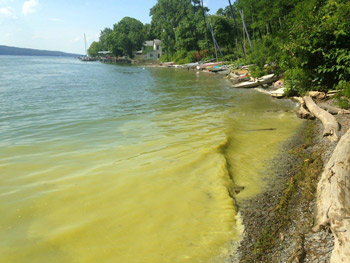
Cyanobacteria blooms, also known as HABs (Harmful Algal Blooms) have been observed at various locations in Cayuga Lake, including in Tompkins County, during the summers since 2017. Trained volunteers and local officials monitor much of the county shoreline for HABs on a weekly basis during the summer. These blooms may be small in size and confined to specific areas of the shoreline and bays. Blooms are often transient, typically lasting only a few hours. Areas where blooms are not observed can continue to be used for recreational use.
The Community Science Institute (CSI), Cayuga Lake Watershed Network, and Discover Cayuga Lake lead a volunteer program to monitor the Cayuga Lake shoreline for HABs during the summer months. To stay alert to blooms occurring on Cayuga Lake, check the Cayuga Lake HABs Reporting Page on CSI’s website.
HABs Status for Beaches & Waterways (local & NYS)
Know where HABs currently are:
Check the Community Science Institute (CSI) Cayuga Lake map before you go.
See something? Report possible HABs to CSI:
CSI's Report-a-HAB web page
By email: habshotline@gmail.com
Call: (607) 257-6606
Recursos adicionales:
NYS Parks:
NYS DEC:
Beware of HABs
Tompkins County Whole Health urges residents and visitors to beware of HABs. These blooms can occur in any calm body of water and may produce toxins that are harmful to people and animals.
- Do not drink the water and avoid contact with the water if it appears discolored or has an unpleasant odor.
- Do not allow pets to swim in water with suspicious cyanobacteria blooms. ]
- Hot weather and intense rain and runoff events can lead to an increase in the presence of HABs.
There is no concern with municipal water supplies at this time. In the unlikely event that a public water supply is affected by HABs, the TCHD will work with the water supply to evaluate the situation and provide notice to affected users.
Know how to identify and report blooms you might discover.
- Know It
- If water appears discolored or has an unpleasant odor, do not drink the water and avoid contact with it.
- To identify harmful and non-harmful algae blooms click here for a photo gallery.
- View this video on YouTube for more information about identifying HABs.
- If you are planning to host a water event, please contact TCHD Environmental Health for guidance: (607) 274-6688. Beaches may be closed due to the presence of HABs. Please contact individual facilities directly for more information.
- Avoid It
- If contact occurs with suspicious HABs, rinse thoroughly with clean water to remove cyanobacteria. For dogs that may have gone in the water, prompt action is particularly important to prevent them from ingesting matter that sticks to their fur. Click here for more information on the risks HABS present to dogs.
- If you are not on a public water supply, be aware that water treatment such as Ultraviolet (UV), boiling, or chlorinating will not make your water safe for use.
- Never drink, prepare foods, make ice, or cook with untreated surface water – whether or not a bloom is present.
- Stop using water and seek medical attention immediately if symptoms such as vomiting, nausea, diarrhea, skin, eye or throat irritation, allergic reactions or breathing difficulties occur after drinking or having contact with blooms or untreated surface water.
- Report It
- If you see a suspicious bloom on Cayuga Lake, stay out of the water and report the bloom to the Community Sciences Institute's Report-a-HAB web page, write to habshotline@gmail.com, or call (607) 257-6606.
- If you see a suspicious bloom in another public body of water, stay out of the water and report the sighting to the NYSDEC by filling out and submitting a Suspicious Algal Bloom Report Form, found here. Email HABSInfo@dec.ny.gov if you are unable to complete the form.
- HABs can also be present in smaller ponds. Residents who have private ponds should monitor their ponds for signs of blooms and avoid contact. Residents may contact Tompkins County Soil and Water Conservation District (SWCD) for guidance on pond management and a possible site visit to view the suspicious bloom.
The NYS Department of Environmental Conservation (NYSDEC) has a map of reported HABs across the State here.
Report any HAB-related health symptoms to the NYS Department of Health at harmfulalgae@health.ny.govand call your health care provider.
Links
- NYS Dept of Health site
- NYS Dept of Environmental Conservation HABs page.
- Cyanobacteria (EPA website)
- HABs Awareness Poster (Letter-size PDF)
- HABs Advisory Poster (Letter-size PDF)


